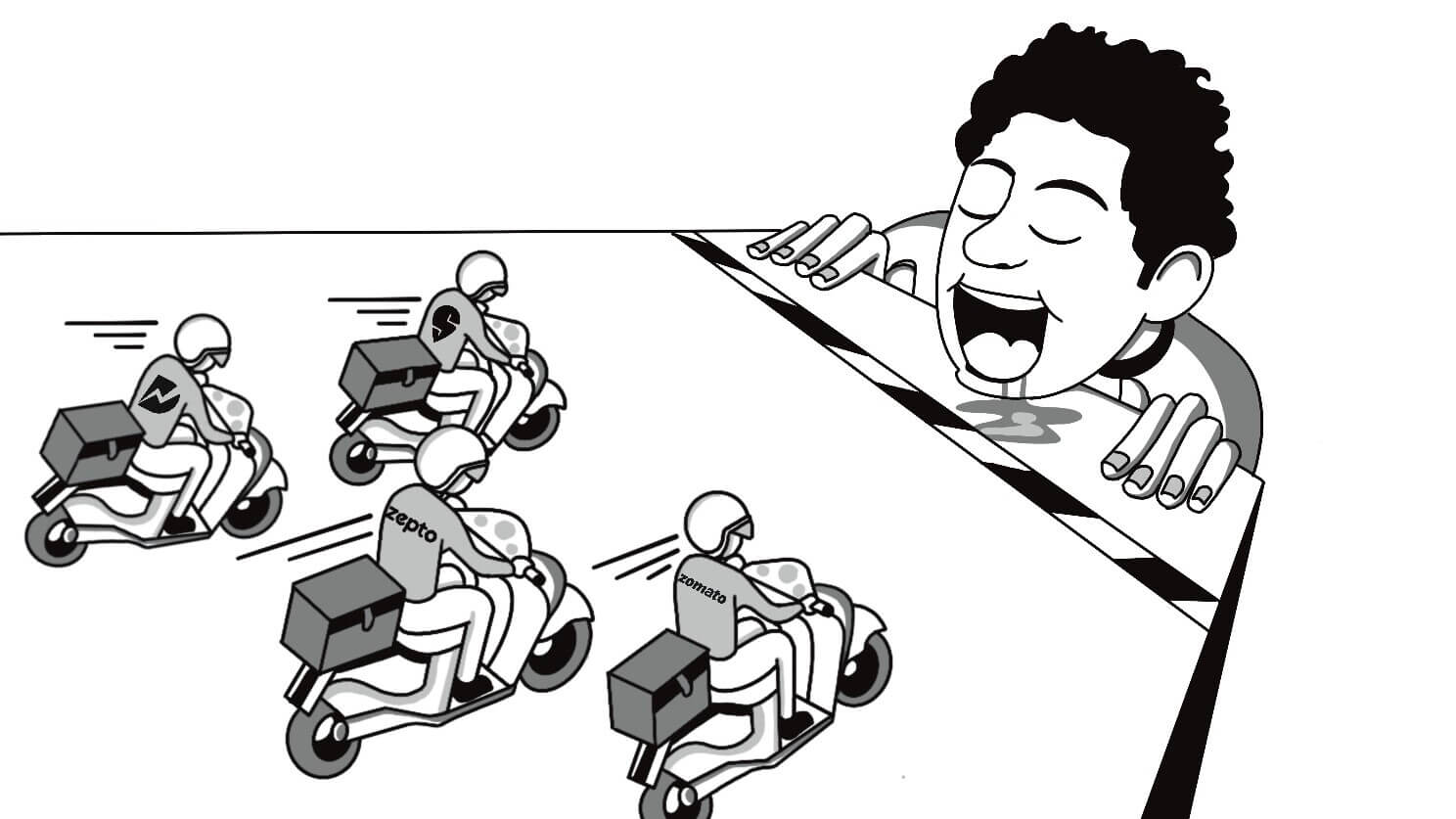In light of the 10-minute revolution at our doorstep, can we spare 10 minutes to consider the human costs of this so-called luxury?
10 minutes.
10 minutes is nothing to …
A woman putting on makeup;
A teen with a smartphone;
The boss when he’s hell-bent on making a speech.
But, that same 10 minutes is an awfully long time when you…
Must put up with an automated menu on a customer care call;
Try to meditate;
Are very, very HUNGRY.
Mr. Deepinder Goyal understands this. As CEO of Zomato, Goyal enjoys some solid street cred in the world of marketing. As a result, Zomato knows how to stay in the news. Zomato Instant, which promises to deliver food that is sterile, fresh, and hot… within 10 minutes seems to be its latest attempt to do so.
A 10/10 idea or cheap thrills for 10 minutes of fame?
When you got a hankering for food and are looking for a champion, Deepinder Goyal is perhaps second only to your mom. As a marketer, I salute him for successfully creating a strong need: guaranteed food delivery in 10 minutes. As a loyal customer of Zomato, I am rooting for innovation that serves the customer better. But I have serious doubts about it this time around. So I decided to talk to a few friends and get their perspectives on it.
Take for instance Zomato Gold. The strategy of targeting customer loyalty through a premium subscription was gold. The subscription charge was nominal and the benefits, mind-blowing: each Zomato Gold member got two dishes for the price of one at any restaurant they went to. Subscribers joined in droves – 40,000 within 3 days of launch and 1,80,000 in six months, generating unbelievable footfalls, restaurants too went on a joining spree. Either they saw it as a partner loyalty program or were made to see it that way.
But, there was a catch. The discounting model would have worked when only a handful of restaurants were offering it and could drive more volume of customers to come in to justify the discount. What went wrong is that more and more restaurants started coming on the program and that eventually brought back the same distribution of the number of customers but now coming in to have a free dish.
The restaurants were charged a joining fee that was used to subsidize their own offerings while Zomato continued to notch up higher and higher sales. It took a while before the restaurants understood that the partner loyalty program was in fact a colossal deep discounting scheme. The benefits for the app and the customers were lopsided. And, they were coming out from their bottom lines. Clearly, Zomato had misunderstood its role in the equation between the customer and the restaurant. Its myopic execution had turned Zomato Gold to dust, eroding the restaurants’ trust in them for the long term.

TLDR-
“All that Zomato comes up with is not gold”
As an agency owner, I have a hunch that 10-minute delivery too will go the same way. My hunch is based on the real-world experience of being laughed out of the kitchen when I asked my mom to make me a dish from scratch within 10 minutes.
That’s why, as a dutiful son, I had to take the discussion to my friends, and here’s what I found: a myriad of perspectives.
Rapid delivery is a growing trend
10 minutes, yes, but why?
Eshe Nelson has aptly decoded the trend in his article, “Rapid grocery delivery is the next step in the wave of venture capital-subsidized luxury serving a generation used to ordering taxi services in minutes, vacationing in cheap villas through Airbnb and having ever more entertainment available on demand.”

To put it simply, this is our need for instant gratification gone on steroids. My friend (who wants to remain anonymous) working at DoorDash – a tech platform similar to Zomato – which also does rapid delivery of groceries in niche markets, confirmed. He said he was perfectly fine with Zomato trying it out as a business model. “I just hope they have enough measures in place to ensure their people operate safely,” he added.
I guess for a lot of us the question is not “Why” but “Why not!”. We wanted our food fast, so we got fast food. But what happens when we want it even faster?
Faster than fast food!
We all know that fast food has its purposes. Two minutes Maggi. 30 minutes for pizza delivery or your order is free. It’s been a boon, right? What’s wrong with Zomato Instant? What problem could you possibly have with receiving fresh, hot food in 10 minutes!?
My friend Anuj Kolvalkar, who works at Volkswagen as a data scientist, explains, “Say you open the app and see two options: one requires you to choose from a short menu dishes that you could be eating 10 minutes from now while the other gives you umpteen choices that take up to 40 minutes to deliver. I’d go for 10-min delivery more often than not. Once you’re hungry, you don’t want to wait. It’s basic.”
It really is, when you look at it that way. Sheer convenience. Pure luxury. Purely one-sided luxury. Never having to anticipate the dish you know you enjoy.
Except.
How do you define fresh?
What is your definition of freshly cooked food? More importantly, what is Zomato’s definition of sterile, fresh, hot food? Does it mean food that was cooked early in the morning and microwaved a few minutes ago? Does it mean food that was assembled on the flame by using vacuum-packed curries prepared three months ago?
Urvesh Mistry, a restaurateur from Mumbai who has collaborated with several aggregators including Zomato really goes for it when he asks, “What fresh food can you cook in 10 minutes? Even juicing a fruit and packing it up takes 12 minutes. It’s simply not possible to cook, pack, and deliver within 10 minutes. Having worked with Zomato, I understand their urge to do something like this but rest assured, you’d have to walk a far stretch to call that food fresh.”
While we’re at it, let me also shamelessly plug in my cousin, Harshal Potnis, proprietor of the famed Potnis Biryani of Pune. He echoes Urvesh’s sentiment asking squarely, “Is there even a need for such a thing? Through the 20 years of Potnis Biryani, we’ve never once issued advertisements; nor have we needed to work with any aggregator. Ever. Our food is always fresh and our biryani is custom-made for each order. We have celebrities sending their chauffeurs from Mumbai to Pune just to pick up their orders. I can tell you this – food bought up in bulk and packaged and stored in kitchens is anything but fresh.”
So, there. Fresh was out.
But, what about food waste?
I asked my friend, an ex-Zomato employee who had been involved in the launch of Zomato Gold. While she’d like to remain anonymous, she did express her awe at the kind of customer data and the amount of data that Zomato possesses. “Zomato can use that data exceptionally well to predict hyperlocal demand for dishes,” she explained.
While that would be an interesting use of technology that other app-based providers too might be looking into, she rightly allayed my concerns over algorithm errors leading to food waste. My understanding is that if algorithms can predict food demand, they could just as well be used to predict the wastage of food.
If this leads to a curbing of food waste by establishing a supply chain to provide the unused food to the less privileged, I’d be rooting for such tech.
So you see, there are pros and cons to how Zomato chooses to operate. But the key question remains. Why stop at 10? How did you arrive at the number 10?
The human costs involved

- When we admire the length and breadth of such a delivery system, are we factoring for the untold pressure it would put on the silent workforce that is sweating it out in the restaurants’ kitchens, dealing with the surges and the drops in the number of orders per whims and fancies of an algorithm?
- What about the delivery agents who often complain about not even having enough time for bathroom breaks.
- What about its impact on road safety?
- I expect Zomato Instant to also carry higher chances of fuelling potential discord among customers and delivery personnel. We have already seen this during COVID times when delivering door-to-door wasn’t always possible.
These issues are human issues that stand to affect those workers who go about silently doing their job risking their lives and livelihoods. Surely, we owe them better work conditions? Can we spare 10 minutes to think about them?
Time to reflect
I feel Zomato would do its customers and its fellow citizens a huge service by letting the 10-min delivery be a vain attempt at marketing itself. I find myself most in agreement with my friend Shounak Devasthale, a Chartered Accountant, who radically challenges Zomato’s intentions as much as its business model.
He says, “If you compare a Zomato which is valued at USD 10 Billion with other industry counterparts with similar valuation numbers, you’d scramble to understand what value does Zomato create. Zomato is not producing even a tenth of the revenue they are. They’re a deep discounting platform and that, as a business, is unsustainable. It’s the reason why they’re investing in other businesses instead of reinvesting in their own.”
Pointedly he adds, “Zomato Instant is proof that they’re running out of ideas. That’s because they’re also running out of time with respect to their journey post-IPO. How to justify their sky-high valuations?”
“I think 10-minute delivery is nothing but a marketing gimmick.”
Phew. I really hope so.
The need for speed?
Speed is addictive. Even more addictive than convenience. Because speed is always justified. It creates a shiny perception of productivity.
I’m truly at a loss to think of instances when you’d need your food to be delivered in 10 minutes flat. Unless I was up to some kind of a sick dare.

